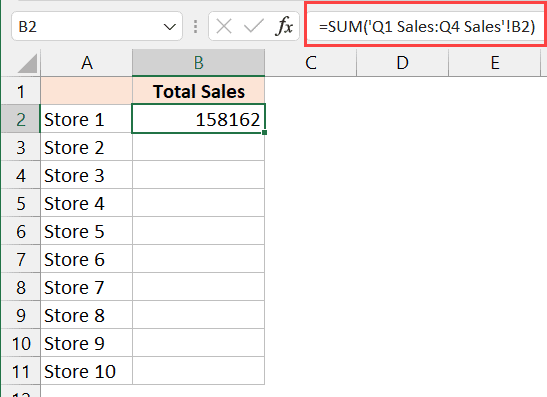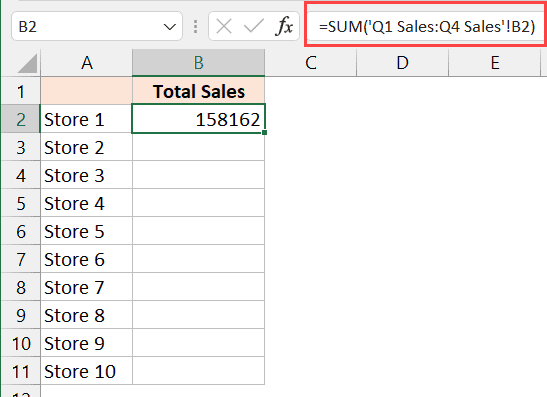5 Ways to Auto-Sum Across Excel Sheets

Excel remains a powerhouse tool for data management and analysis in offices worldwide. One of the more advanced features that can streamline your workflow significantly is the ability to auto-sum data across multiple sheets. This not only saves time but also reduces errors associated with manual data entry. Here, we explore five effective methods to achieve this in Excel, making your data aggregation effortless and accurate.
1. Using 3D References

3D references are a nifty Excel feature that allows you to reference the same cell across multiple sheets in a workbook. This method is particularly useful when you’re dealing with consistent data structures:
- Activate the sheet where you want the sum to appear.
- In the cell where you want the sum, type =SUM( and click on the sheet tab where the data begins.
- Select the range of cells for the first sheet. Then, use a comma to separate each subsequent range or sheet reference.
- Alternatively, you can use Shift + click to select the last sheet, and Excel will automatically fill in the range for all sheets between the first and the last selected.
- Close the parenthesis and hit Enter.
2. Consolidate Function

The Consolidate feature in Excel provides an easy way to sum data from several worksheets into one:
- Select the cell where you want the consolidated sum to appear.
- Go to the 'Data' tab, select 'Consolidate', choose 'Sum' from the function list.
- In the 'Reference' section, add the ranges from the sheets you want to sum. Each range should be from a different sheet.
- Click 'Add' after each range, then hit 'OK'.
✨ Note: You can use 'Link to source data' for dynamic updates if any changes occur in the source sheets.
3. Power Query for Advanced Users

Power Query offers advanced functionality for data management, allowing you to combine data from different sources:
- Go to the 'Data' tab, select 'Get Data', then choose 'From Other Sources'.
- Select the sheets you want to consolidate, load them, and then use 'Append Queries' to combine the data.
- After combining the data, you can use Excel’s built-in SUM function to get the total across all sheets.
📊 Note: Power Query is excellent for large datasets and complex transformations.
4. Using VBA Macros

For repetitive tasks or complex data aggregation, VBA can automate your summing process:
- Press Alt + F11 to open the VBA editor.
- Insert a new module, and write a VBA code to loop through each sheet, sum a specific range, and output the results.
- Here's a simple example:
Sub SumAcrossSheets()
Dim ws As Worksheet
Dim totalSum As Double
Dim rangeToSum As Range
totalSum = 0
For Each ws In ThisWorkbook.Worksheets
Set rangeToSum = ws.Range("B2:B100") 'Adjust this range as needed
If Not Intersect(rangeToSum, ws.UsedRange) Is Nothing Then
totalSum = totalSum + WorksheetFunction.Sum(rangeToSum)
End If
Next ws
MsgBox "The total sum is " & totalSum
End Sub
💻 Note: This code can be adapted for different ranges or conditions.
5. Indirect Function

The INDIRECT function allows for dynamic sheet referencing, useful when sheet names change or when you need to reference sheets by name:
- In the cell where you want the sum, enter =SUM(INDIRECT("Sheet"&ROW(A1:A100)&"!B2")).
- Here, assuming "Sheet" precedes the number, like "Sheet1", "Sheet2", etc.
- Adjust the formula according to your workbook's structure.
🔍 Note: This method is less straightforward but provides flexibility if sheets might change.
These techniques open up a world of possibilities for managing data across multiple sheets in Excel, making it much more than just a spreadsheet tool. By mastering these methods, you can significantly enhance your productivity and ensure data accuracy, which is crucial for any professional environment. Whether you're a beginner or an expert, there's always something new to learn in Excel's vast capabilities.
Can these methods be used across workbooks?

+
Yes, but methods like 3D references and VBA Macros might need slight modifications or external references setup to work across different workbooks.
How do I ensure my formulas are updated if sheets are renamed or moved?

+
Using names for sheets or the INDIRECT function can help. Excel will update these references automatically.
What are the performance impacts of using these methods?

+
Methods like Power Query or VBA can slow down Excel if used on very large datasets, whereas 3D references are relatively lightweight.
Is there a way to sum data dynamically as new sheets are added?

+
With VBA, you can write a macro to loop through all sheets, sum data dynamically, and ensure it works even when new sheets are added.



